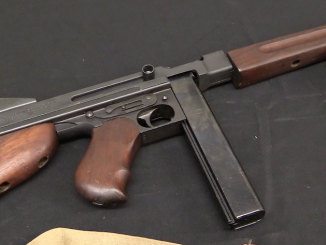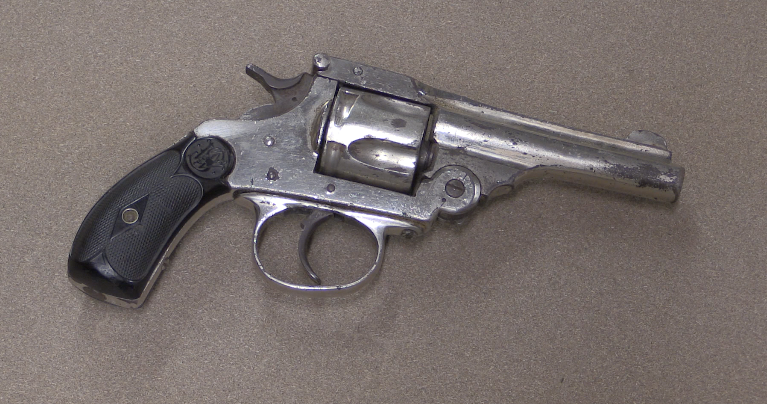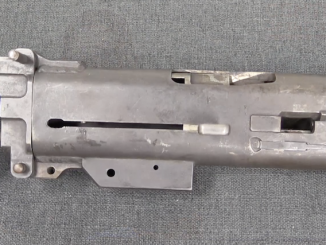After a dismal first attempt at designing a flamethrower (the M1) in 1941, the US Chemical Corps along with several universities and industrial partners put in a lot of research to develop a more usable and effective flamethrower. The result was the M2, which went into production in early 1944. It would prove to be an exceptionally effective weapon in the island-hopping campaign towards the end of the war.
The M2 was arguably the best flamethrower fielded by any military during the war, with a number of excellent design features. These included:
- A constant-pressure regulator to ensure that the range stayed the same from the first to the last shot of a tank of fuel
- An on/off main valve easily accessible to the operator
- A supremely waterproof and reliable pyrotechnic cartridge ignition system
- An auto-shutoff valve which sealed at the nozzle, preventing dribble (and cutting off fuel flow should the operator lose control of the weapon)
The M2 would see service into the Vietnam War even as its successor the M9 was being issued. It was a truly outstanding design, and remains viable to this day.
Thanks to Charlie Hobson for showing us the unit and teaching me to fire it, and also thanks to Adaptive Firearms for letting us use their range facilities! For more details on this and other military flamethrowers, I recommend Charlie’s book: US Portable Flamethrowers.




Obviously a devastating weapon against the dug-in Japanese in WWII–after it was introduced in numbers did the Japanese change tactics in any way in response to it?
it would be interesting to compile case histories of weapons that were design collaborations that actually worked well–what was different between committees that hit a home run and the committees that only managed to whack themselves in the head with the bat? Plenty of examples of both.
There are definitely studies about the effectiveness of teams in innovation. Things like trust amongst the members, shared values, diverse skills, etc.
Try a search for scholarly research:
https://scholar.google.com/scholar?q=properties+of+effective+teams
Great review Ian! I was glad the Marine Corps ceased using the M202 (flamethrower replacement) before I joined. I do not dig fire, especially if someone was shooting at me. Flamethrower operator’s were brave souls.
Question- Where does one find ignitor cartridges today? Are there that many left in surplus?
“An auto-shutoff valve which sealed at the nozzle, preventing dribble (and cutting off fuel flow should the operator lose control of the weapon)” The latter being handy incase they get shot amongst other things, a problem which can occur with fly off lever grenades when the pin has been removed if the operator lets go of the grenade for some reason… Being shot, for example. British ones come with safety clips around the fly off lever, which must be removed in order to operate it. I get the idea of the fly off lever being akin to a trigger, if the pin is the safety. But I do wonder if it might be an idea to have the pin as the safety, the fly off lever as a trigger “sear” so to speak, and the trigger as a modification to the current design in that there’s a circular rotating “split band” mounted centrally which you operate with your thumb by rotating it around the grenade so the split in said band passes the fly off lever were it previously covered it allowing it to disengage. This would allow for single handed operation like now, after removing the pin obviously. But if you were shot on your way to “posting” the grenade, letting go of it wouldn’t cause it to activate.
Flamethrowers – Holy cow!
It’s a very well thought out weapon design, and it’s certainly fearsome. The metal quick release harness buckles are good, they hold 70lb and are better than the plastic ones with the same idea behind them on some rucksacks.
Thank you for shooting this great footage; it’s not everyday that you get to see a flamethrower in slow-motion. Was the fuel that you used on the range gelled, or was it just straight-up liquid?
I asked Ian the same question over at Full30 and he wrote that it was straight #2 diesel.
Based on this video,
The Central fire appears more hottest than outer vapors,this is what gives potent power to the flamethrower not an outer vapor of flame…..
Although not liquefied plasma but still consider very powerful,if flamethrower would run on that powerful stream alone things would be even more bad,metal also could be melt like from the torch…..
When everyone was study chemistry and physics would know that blue flame is cold flame,yellow is mixed gasses and red is very hot temperature..
So when you use Acecylene torch and blue flame exposed it would take very while to heat metal or it won’t even heat as desires,as long torch set on visible red flame things get heat up faster or even cut……
Same result goes in flamethrower,everything depands on amount of fuel and air mixture plus it’s equivalent..
I remember that the Red Army resorted to disguising the ROKS flamethrower as a rifle and backpack set to avoid the old “shoot the guy with the weird weapon first” gag the Finns would use for obvious reasons. Did that work at all?
“Shoot the guy with the weird weapon first.”Sound a lot like how chickens will peck the chicken with the wired deformities to death.
“ROKS”
Description in Russian here: http://russianguns.ru/?p=4960
click скачать подборку детализированных фотографий огнемета РОКС-3 10,5 Mb to get photos of museum exhibition example photos
click скачать инструкцию по эксплуатации ранцевого огнемета РОКС. 1946 г. 3,9 Mb to get manual from 1946 (you will need .djvu file viewer)
Red Army fielded three flame-thrower of this name: РОКС-1, РОКС-2, РОКС-3 in all cases РОКС stands for Ранцевый Огнемет Клюева Сергеева – Р.О.К.С (Backpack flamethrower [design of] Клюев [and] Сергеев) it has air in tank under pressure 150 atm connected to fuel tank via pressure reductor (lowering pressure to 17 atm) atm and one-way valve, ignition was done by special variant of 7.62×25 Tokarev cartridge which don’t have bullet and special powder (same as used in starshell*) topped with paper wad. It has revolver-like drum for 10 such cartridges.
Following fuels are allowed:
LIQUID
diesel fuel
raw naphtha (only Summer and Fall)
50% mazut + 25% kerosene + 25% gasoline (% by volume)
60% mazut + 25% kerosene + 15% gasoline (only when air temperature >=-10°C)
50% creosete + 30% зеленое масло** + 20% gasoline (only Summer)
All above give range 20-25m for РОКС-3
VISCOUS
(liquids with addition of ОП-2 powder)
give boost for range due to anomalous viscosity
mixture No.1: based on automobile gasoline
mixture БГС: 70% зеленое масло + 30% головка бензольная*** (or 50%+50%)
50% kersone XOR 50% diesel fuel + 50% gasoline (only Summer)
Range: 30-35m, how many of ОП-2 is inserted decide also about flame-throwing arc (narrow/wide)
*type of projectile used in artillery (ILLUM in U.S.Navy parlance)
**jargon name for антраценовое масло (I don’t know American name), not to be confused with ingredient for food preparing
***again I don’t know name in American parlance
By deduction, I guess антраценовое масло is a kind of oil made from anthracite.
After few reserches, I assume English name might be “anthracene oil”.
For головка бензольная, I take got something like “head gazoline”. Could it be a byproduct that comes just before gazoline while petroleum is refinded?
Did the Russians use them primarily against German bunkers? Or were they used for orher ends as well?
http://www.essexhmva.co.uk/education/References/Weapons/US%20Flamethrower%20History.pdf
Wow the igniter cartridges are hard to find. The rewats I’ve seen and fired all used a cheap propane torch.I suppose Charlie bought all the the cartridges when it came up for surplus in the 80’s.
How long does the nitrogen tank last? Refill every time you do the fuel, or once every several times?
Thanks!
The propelling gas/air tank need to refilled when you fill the fuel tanks.
Well Ian, that was incredible! I’ve always wondered how those worked after seeing them in WWII newsreels and movies. Very impressive weapon. Your video was very well done and complete. Loved it!
While very fascinating mechanically, I do not envy the man who had to wield such a weapon. Is there anything to suggest PTSD as being more common among soldiers equipped with flamethrowers during the war? I cannot imagine anyone having to use one against other people being very keen to do so.
About fifteen years ago, I saw a replicated Japanese pillbox at the National Museum of the Pacific War in Fredericksburg, Texas. The museum staff would bring out their flamethrower to use for demonstrations on the pillbox. I remember the heat and the smell of napalm quite clearly.